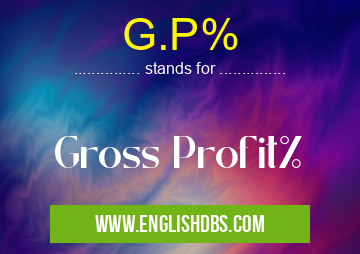What does G.P% mean in ACCOUNTING
G.P% is an abbreviation for Gross Profit percentage in business. It is a financial term that reflects the amount of profit per dollar of sales after subtracting the cost of goods sold. G.P% is an important metric used to measure the profitability of a given business and can be used to compare its performance against peers in the industry or other businesses.

G.P% meaning in Accounting in Business
G.P% mostly used in an acronym Accounting in Category Business that means Gross Profit%
Shorthand: G.P%,
Full Form: Gross Profit%
For more information of "Gross Profit%", see the section below.
» Business » Accounting
Essential Questions and Answers on Gross Profit% in "BUSINESS»ACCOUNTING"
What is Gross Profit?
Gross profit is the total revenue of a business minus the cost of goods sold. This figure indicates how much money a business has generated after deducting all its associated costs.
How does Gross Profit affect businesses?
The higher the gross profit, the more successful a company is in leveraging its resources to generate income. A high gross profit margin also allows companies to reinvest their profits into pursuing growth opportunities and expanding operations.
What is Gross Profit Percentage?
Gross Profit Percentage (GP%) is calculated by dividing the gross profit figure by total sales, multiplied by 100. It provides an indication of how effective an organization’s pricing strategies are and how efficiently it produces products and services.
What is a good Gross Profit Percentage?
There isn't a definitive answer, as what constitutes a ‘good’ GP% depends on the sector, type of product or service offered, and other factors. Generally speaking, for established businesses, GP% should be around 50%, but this can vary greatly from industry to industry.
How can I calculate my company's Gross Profit Percentage?
The formula for calculating Gross Profit Percentage (GP%) is as follows; GP% = (Gross Revenue – Cost of Goods Sold) / Total Revenue x 100.
Why is it important to track Gross Profit Percentage?
Tracking your company’s GP% helps you gain an overall view of your organization’s performance and profitability relative to competitors in your sector or industry. This metric can also help you gauge whether changes made in terms of pricing models, production methods or cost-cutting measures are sufficient to improve margins and profitability over time.
How can I increase my company's Gross Profit Percentage?
Depending on your situation there are various things you could do to improve your company’s GP%. For example, reducing costs associated with production processes, adopting more flexible pricing models that reflect customer demand and investing in additional marketing activities to boost sales all offer potential routes for increasing GP%.
Is increasing prices always the best way to increase Gross Profit Margin?
Not necessarily - while raising prices may seem like an easy solution it could have unintended consequences such as alienating customers who are price-sensitive, driving up operating costs due to additional competitive incentives or making it difficult for small businesses within certain sectors to compete with larger firms offering discounts at lower prices. Therefore it should be considered one option amongst many when looking for ways to increase GP%.
Final Words:
G.P% is an important metric for businesses as it provides insight into how efficiently they are managing their finances and whether or not their efforts are paying off in terms of profitability. By understanding what drives their G.P%, companies can focus on improvements and strategies that will help drive profits even higher while avoiding costly mistakes or inefficient decisions that may lead to reduced profits over time.
